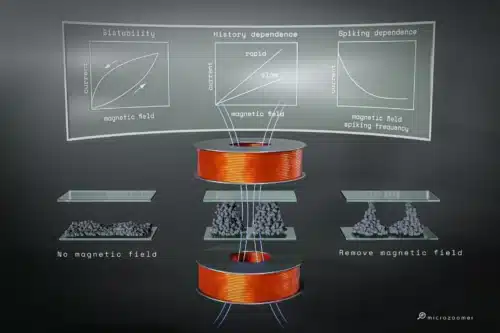Researchers have developed a material that has a memory and changes it behavior based on past experiences.

We are moving towards the artificial intelligence (AI) revolution which in itself is quite a breakthrough for technology, but what if the material had its own intelligence? This could lead to advancement on another level. Devices that could change their behavior based on past experiences could help the machine learning programs and make AI more efficient as well.
Researchers at Aalto University have developed a new material that changes its electrical behavior based on previous experience, effectively giving it a basic form of adaptive memory. Responsive materials have become common in a range of applications, from glasses that darken in sunlight to drug delivery systems. However, existing materials always react in the same way each time. Their response to a change doesn’t depend on their history, nor do they adapt based on their past.
The researchers synthesized micrometer-sized magnetic beads which were then stimulated by a magnetic field. When the magnet was on, the beads stacked up to form pillars. The strength of the magnetic field affects the shape of the pillars, which in turn affects how well they conduct electricity. “With this system, we coupled the magnetic field stimulus and the electrical response. Interestingly, we found that the electrical conductivity depends on whether we varied the magnetic field rapidly or slowly. That means that the electrical response depends on the history of the magnetic field. The electrical behavior was also different if the magnetic field was increasing or decreasing. The response showed bistability, which is an elementary form of memory. The material behaves as though it has a memory of the magnetic field,” explains Bo Peng, an Academy Research Fellow at Aalto University.
The system’s memory allows it to behave in a way that resembles rudimentary learning. Researchers were inspired by the working of neurons. Depending on how frequently they are stimulated, synapses in a neuron will become harder or easier to activate. This change, known as short-term synaptic plasticity, makes the connection between a pair of neurons stronger or weaker depending on their recent history. Researchers applied this knowledge in their experiment. When they exposed the beads to a quickly pulsing magnetic field, the material became better at conducting electricity, whereas slower pulsing made it conduct poorly.
“In the future, there could be even more materials that are algorithmically inspired by life-like properties, though they won’t involve the full complexity of biological systems. Such materials will be central to the next generation of soft robots and for medical and environmental monitoring,” adds Aalto’s Distinguished Professor Olli Ikkala.
Reference: “Magnetic field–driven particle assembly and jamming for bistable memory and response plasticity” by Xianhu Liu, Hongwei Tan, Carlo Rigoni, Teemu Hartikainen, Nazish Asghar, Sebastiaan van Dijken, Jaakko V. I. Timonen, Bo Peng and Olli Ikkala, 11 November 2022, Science Advances. DOI: 10.1126/sciadv.adc9394







